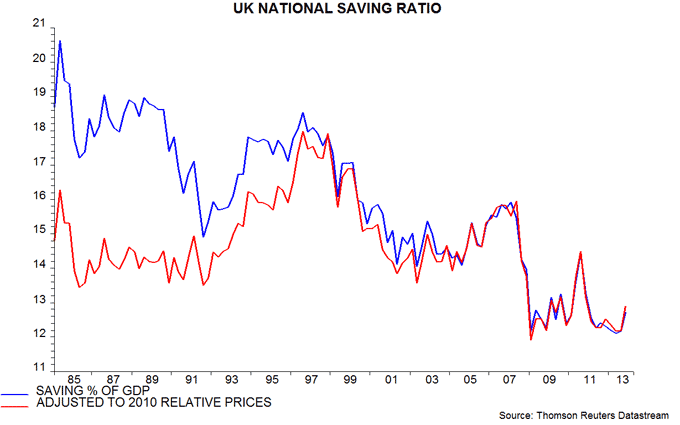Is UK national saving too low?
The Office for National Statistics recently announced that its implementation of a new accounting framework in September 2014 will substantially boost the household saving ratio. Specifically, the increasing pension entitlements of members of funded defined benefit schemes will, from September, be included in income and saving. Initial work indicates that the change will boost annual saving ratios over 1997-2011 by between 3.4 and 6.3 percentage points. The saving ratio of 5.0% in the fourth quarter of 2013 could rise to about 10%.
The Financial Times article that covered this story was titled “Data shake-up turns UK into nation of savers”. The pension accounting change, in fact, will have no impact on the national saving ratio. The rise in the household ratio will be counterbalanced by a fall in recorded saving of companies and government bodies responsible for funded defined benefit schemes. The change, indeed, should turn the current corporate financial surplus – the excess of retained income over capital spending – into a deficit.
Total national saving out of domestic income was equal to 12.7% of GDP in the fourth quarter. This ratio has trended sideways since the 2008-09 recession but is far below its average of 16.0% since 1985 – see chart.
Is this a concern? Saving is necessary to fund capital accumulation to support supply-side growth. The relative price of capital goods, however, has been trending lower in recent decades, partly reflecting the IT revolution. A given national saving ratio, therefore, funds a higher real investment share of GDP than in the past. The chart shows an alternative measure that adjusts for this relative price effect*. This real saving ratio is much closer to its long-run average.
The value of saving, moreover, depends on the quality of the investment it finances. The real saving ratio rose above average over 2006-07 but much of the associated capital accumulation was misdirected, as evidenced by a subsequent prolonged slump in productivity. If capital allocation has improved, the current low ratio may not act as a constraint on long-run economic growth.
A rise in aggregate saving would be welcome and may occur if fiscal consolidation continues and the Bank of England normalises interest rates. The current saving ratio is of less concern for longer-run economic prospects than the risk that the Bank will hold rates below a rising “neutral” level, as it did during the mid 2000s, resulting in further capital misallocation.
*The alternative measure shows the hypothetical saving ratio that would have had the same purchasing power in terms of capital goods assuming prices fixed at their 2010 level.

Reader Comments